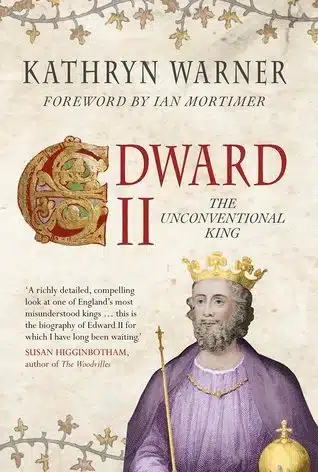Please scroll down for an English review.
👑 אדוארד השני: המלך שלא ידע להיות מלך
יש מלכים שמולידים מיתוסים, ויש מלכים שהמיתוסים נולדים על חשבונם.
אדוארד השני שייך לסוג השני, מלך שביקש להיות אדם, בעולם שבו האנושיות נחשבה חולשה.
קתרין וורנר, מההיסטוריוניות המדויקות והרגישות ביותר שכתבו על ימי הביניים האנגליים, משיבה את אדוארד השני ממעמקי הקריקטורה שבה ההיסטוריה כלאה אותו במשך שבע מאות שנה.
היא מפרקת את המיתוס לגורמיו: שמועות, תעמולה, תיאטרון, לעומת תיעוד אמיתי: מכתבים, צווים, יומנים ותשלומים.
מתוך הארכיון היבש הזה היא בונה סיפור מצמרר, שבו כל חולשה אנושית הופכת לכתב אישום פוליטי.
👶 ילד שלא היה אמור למלוך
אדוארד נולד בצלו העצום של אביו, אדוארד הראשון, “פטיש הסקוטים”, מלך צבאי, קנאי למשמעת, נוקשה, ונטול רוך.
הילד הרך שגדל לצדו העדיף מוזיקה על חרבות, חיות על קרבות, ואהבה על כוח.
אביו ראה בו פוחז חסר תקנה; במשך חצי שנה סירב לדבר איתו, לאחר שהבין את עומק הקרבה הבלתי נפרדת בינו לבין פירס גאווסטון.
גאווסטון יצא לגלות ביבשת אירופה בהוראת אדוארד הראשון, ולמרות תחנוניו של אדוארד השני, סירב המלך להתיר את חזרתו לממלכה.
על ערש דווי הורה שלא להחזיר את גאווסטון מהגלות. הוא כבר הבין שבנו לא קורץ מחומר של מלכים.
וכך, עוד לפני שהומלך, נחרץ גורלו של הבן לחיות בצל הציווי שהפר ובכך, לא רק להיכשל, אלא להיחשב לחרפה.
💔 גאווסטון: אהבה שהפכה לקללה
כשהומלך ב־1307, אדוארד החזיר את גאווסטון מהגלות והפך את אהבתו למעשה פוליטי.
וורנר מתארת את הקשר ביניהם באיפוק מרשים: ייתכן שהיה רומנטי, וודאי שהיה עמוק וחריג בתקופה שבה רגשות נחשבו חולשה.
בכל מקרה זו הייתה מערכת יחסים של תלות הדדית.
האצולה ראתה בכך עלבון וסטייה מסדר העולם.
הם לא סבלו את העובדה שמלך מעניק תארים ואדמות לאדם שנתפס כנחות, אולי גם “נשי מדי”.
בשנת 1312, כאשר גאווסטון נלכד ונרצח באכזריות בידי האצילים, המלך פשוט נשבר ולא התאושש עוד.
שלוש שנים סירב לקבור את גופתו; ארבע עשרה שנה שילם על תפילות לעילוי נשמתו.
בעודו שקוע באבל, ממלכה שלמה שקעה איתו.
⚔️ מלך בלי אצולה
מות גאווסטון סימן את ראשית הסוף.
האצולה ראתה במלך אדם רגשני, בלתי צפוי, ומנותק מהמציאות.
וורנר מציגה כיצד ניסה אדוארד למלא את החלל שנוצר באמצעות יועץ חדש, יו דספנסר הבן, שהפך במהרה לשליט בפועל.
דספנסר מונה למזכיר המלך בשנת 1318 בתקווה לגשר על הפערים שנוצרו בין אדוארד והאצולה בעקבות ההפסד הצורב בקרב באנוקברן (1314) והרעב הגדול של השנים 1315 – 1317.
אך במהרה הפך מהפתרון לבעיה.
בעניים כלות חזו האצילים כיצד האחרון מרוקן את קופת המדינה, מחרים אדמות, ומשפיל את בני מעמדו.
המלך שאביו היה “פטיש הסקוטים”, הפך לסמל של כישלון לאומי.
לצד זאת, וורנר מתארת את הפער הבלתי נתפס בין עולמו הפנימי של המלך למציאות שמסביבו:
בזמן שהעם גווע ברעב הגדול (1315–1317), אדוארד טיפל בגני חיות, שילם להאכלת חיות אקזוטיות, והתפלל למען נשמת גאווסטון.
זו לא אדישות, כותבת וורנר, אלא ניתוק של אדם שלא נולד לשלוט.
👑 איזבלה מצרפת האישה היחידה שראתה?
וורנר מתמודדת באומץ עם הדמות השנויה במחלוקת של איזבלה מצרפת.
היא אינה מציגה אותה כאישה אכזרית, אלא אלא כאישה שהושפלה והושתקה שנים ארוכות.
דספנסר החרים את נכסיה, ניתק אותה מבעלה, והפך אותה לשקופה בחצר.
כשהמלך שלח אותה לצרפת בשליחות דיפלומטית, היא ניצלה את ההזדמנות ולקחה איתה את בנה, יורש העצר אדוארד השלישי, ומשם היא פשוט לא חזרה.
שם, יחד עם רוג’ר מורטימר, יצרה את אחד המהלכים הנועזים בהיסטוריה: פלישה לאנגליה והדחת המלך.
לא מרצון לנקום, אלא מתוך אינסטינקט הישרדות.
זו לא הייתה בגידה; זו הייתה תגובה לעולם שבו לא נותרה לה שום דרך אחרת.
🕯️ מותו של מלך או מיתוס שנולד בכלא ברקלי
הפרק האחרון הוא לב הספר.
הגרסה הרשמית טענה שאדוארד נרצח בכלא ברקלי במוט מלובן, עונש שנחרט בדמיון הקולקטיבי כנקמה מינית על סטיותיו.
וורנר מפרקת את הסיפור ומראה שמקורו מאוחר, מתקופת טיודור, ושלא הייתה לו אחיזה במקורות בני הזמן.
היא בוחנת את אותו מכתב מסתורי משנת 1337, המעיד כי אדוארד נראה חי וגם מת בשנים מאוחרות יותר באיטליה.
היא מצביעה כיצד כל הדמויות סביב מותו, כולל הלורד ברקלי עצמו, הודו כי לא ראו את הגופה.
הפנים היו מכוסות, הנשים שעסקו בהכנת הגופה לא הכירו אותו,
וההודעה על מותו נמסרה רק שבועות אחרי המאורע.
בספר של אליסון ויר (Queens of the Age of Chivalry סקירה עתידית) מצאתי חיזוק להשערה זו: ייתכן שהמלך נמלט, אולי במעורבות של מקורב שהזהיר אותו, והוחלף באחר.
אם כן, הרי שכל סיפור הרצח המפורסם הוא לא אלא תעמולה טיודורית קלאסית
עוד פרק במאמץ לעצב היסטוריה שבה כל מלך קודם נתפס כראוי לגורלו.
👑 ירושה של לב חלש
בנו, אדוארד השלישי, צמח לתוך הטראומה.
הוא בנה מלוכה המבוססת על כוח צבאי, כיבושים ויוקרה. ההיפך הגמור מאביו.
אבל וורנר רומזת שכל עוצמה כזו היא תמיד תגובה לחולשה.
אדוארד השני אהב יותר מדי; אדוארד השלישי נלחם יותר מדי.
האנגלים, כך נדמה, למדו להעדיף חרב על פני לב וכך, במשך 200 השנים הבאות ההיסטוריה האנגלית תמשיך לנוע בין שני קטבים: רגש וכוח, לב וחרב.
💬 סיכום
Edward II: The Unconventional King הוא לא רק ביוגרפיה, אלא תיקון היסטורי ומוסרי.
וורנר משיבה את אדוארד השני למקום שממנו סולק.
היא לא משיבה לו את כס המלכות, אלא מושיבה אותו על ספסל האנושיות.
היא לא מתאהבת בו, אבל היא רואה אותו.
והקריאה הזו, בסבלנות הארכיונית שלה, מזכירה עד כמה קל למחוק אדם כשלא נעים לזכור שהוא היה אדם.
Edward II: The Unconventional King/ Kathryn Warner
Kindle Edition, 2015, 434 Pp
דירוג SIVI –
איכות אודיו –

👑 Edward II: The King Who Didn’t Know How to Be a King
Some kings create myths; others become their casualties.
Edward II belongs to the latter—a man who tried to be human in a world that mistook humanity for weakness.
Kathryn Warner, one of the most precise and empathetic historians of medieval England, rescues Edward II from the caricature where history had imprisoned him for seven hundred years.
She dismantles the myth piece by piece: gossip, propaganda, theatre – and contrasts them with factual evidence: letters, royal decrees, journals, and financial records.
From this dry archive, she rebuilds a chilling story, where every human weakness becomes a political indictment.
👶 A Child Who Wasn’t Meant to Rule
Edward was born under the vast shadow of his father, Edward I, the “Hammer of the Scots,” a soldier-king, strict, disciplined, and devoid of tenderness.
The young prince preferred music to swords, animals to battles, love to power.
His father saw him as hopelessly frivolous. For six months, he refused to speak to him after realizing the depth of Edward’s attachment to Piers Gaveston.
Gaveston was exiled to the Continent by Edward I, and despite the younger Edward’s pleas, the king forbade his return.
On his deathbed, he reiterated the command. He already knew his son was not made of the same royal metal.
Thus, before he even wore the crown, the son’s fate was sealed: to live in the shadow of a broken oath and to be remembered not merely as a failure, but as a disgrace.
💔 Gaveston: A Love Turned Curse
When crowned in 1307, Edward brought Gaveston back from exile and turned affection into policy.
Warner describes their bond with impressive restraint: perhaps romantic, indeed profound and rare in an age when emotion was weakness.
It was a relationship of mutual dependence.
The nobility saw it as an affront to order a scandal and a perversion.
They could not bear that a king would bestow lands and titles on a man deemed inferior, perhaps too “feminine.”
In 1312, when Gaveston was captured and brutally murdered by the nobles, the king simply broke – and never recovered.
For three years, he refused to bury Gaveston’s body; for fourteen years, he paid for masses for his soul.
While he mourned, a kingdom drowned with him.
⚔️ A King Without His Nobility
Gaveston’s death marked the beginning of the end.
The nobles saw their king as emotional, erratic, and detached from reality.
Warner shows how Edward tried to fill the void with a new favorite – Hugh Despenser the Younger – who soon became the absolute ruler.
Appointed royal chamberlain in 1318, Despenser was meant to reconcile court and crown after the crushing defeat at Bannockburn (1314) and the Great Famine of 1315–1317.
Instead, he became the problem itself.
The peers watched helplessly as he emptied the treasury, seized lands, and humiliated his equals.
The son of the “Hammer of the Scots” became the symbol of national failure.
At the same time, Warner exposes the chasm between the king’s inner world and his dying realm:
While the people starved, Edward tended his menagerie, paid for exotic animals, and prayed for Gaveston’s soul.
This wasn’t indifference, she argues – it was detachment. A man not born to rule.
👑 Isabella of France – The Only One Who Saw Him
Warner tackles the notorious figure of Isabella of France with rare balance.
She is not a villainess, but a woman humiliated and silenced for years.
Despenser confiscated her estates, isolated her from her husband, and made her invisible.
When the king sent her to France on a diplomatic mission, she took her chance – and her son, the heir Edward III – and never returned.
Together with Roger Mortimer, she led one of the boldest coups in English history: the invasion of England and deposition of the king.
Not out of revenge, but survival.
It wasn’t treason; it was self-preservation in a world that left her no other choice.
🕯️ Death of a King – or the Birth of a Myth
The final chapter is the book’s haunting core.
The official story claims Edward was murdered at Berkeley Castle by a red-hot poker, a punishment engraved in the collective imagination as sexual revenge.
Warner dismantles the legend, tracing its origins to the Tudor chroniclers, not to contemporary sources.
She examines a mysterious 1337 letter suggesting Edward was seen alive, and perhaps died years later in Italy.
All who surrounded his supposed death, including Lord Berkeley himself, admitted they never saw the body.
The face was covered, the woman who prepared it didn’t recognize him,
and the announcement of his death came weeks after the event.
Alison Weir’s Queens of the Age of Chivalry (to be reviewed later) echoes this theory: perhaps the king escaped, warned by a loyal ally, and was replaced by another.
If so, the infamous murder becomes nothing more than Tudor propaganda,
another chapter in the effort to craft a history where every fallen king was deemed to deserve his fate.
👑 The Inheritance of a Tender Heart
His son, Edward III, grew from trauma.
He built a monarchy on military might, conquest, and glory – everything his father was not.
But Warner suggests that every strength is born from weakness.
Edward II loved too much; Edward III fought too much.
The English, it seems, learned to prefer the sword to the heart,
And for two centuries, their history would swing between those poles: feeling and force, heart and blade.
💬 Conclusion
Edward II: The Unconventional King is not just a biography but a moral correction.
Warner restores Edward II to the seat from which history expelled him.
Not the throne, but the human bench.
She does not idealize him, but she sees him –
and that, in the end, may be the most radical act of all:
To remember that a king once dismissed as a failure was, first of all, a man.
לגלות עוד מהאתר Sivi's Books
Subscribe to get the latest posts sent to your email.

